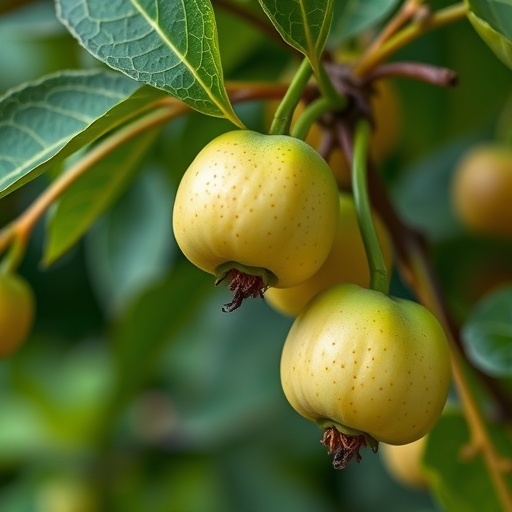A groundbreaking phosphoproteomic study has unveiled novel insights into the molecular orchestration of bud dormancy in litchi (Litchi chinensis), a tropical evergreen fruit tree. Conducted by Ren-Fang Zeng and Xu-Ming Huang’s team at South China Agricultural University, this comprehensive research deciphers how post-translational modifications, especially protein phosphorylation, regulate the critical dormancy-to-growth transition in litchi terminal buds. The findings, published in the open-access journal Tropical Plants, illuminate the intricate biochemical landscapes governing perennial bud development and open promising avenues for agronomic manipulation of flowering cycles in tropical fruit crops.
Bud dormancy, a physiological state allowing plants to endure adverse environmental conditions, has been primarily studied in temperate species with a focus on transcriptional regulation. However, in tropical evergreens such as litchi, where dormancy occurs despite optimal climatic conditions, the underlying regulatory mechanisms appear to be fundamentally intrinsic and less influenced by environmental stressors. The research team embarked on a pioneer investigation into the phosphoproteomic dynamics underlying these processes, aiming to fill the considerable gap in knowledge regarding post-translational modifications in tropical bud dormancy.
Utilizing state-of-the-art label-free quantitative phosphoproteomics, the study deployed high-resolution liquid chromatography-tandem mass spectrometry (LC-MS/MS) to map phosphorylation events across four distinct developmental stages of litchi terminal buds: two dormancy phases (S1 and S4), bud break (S2), and rapid growth (S3). This high-throughput methodological approach enabled the identification of an extensive array of phosphorylated peptides, amounting to 7,835 unique phosphopeptides corresponding to 6,785 phosphorylation sites distributed over 2,795 phosphoproteins. Such an expansive dataset marks the first comprehensive phosphoproteomic profile for litchi bud dormancy.
The phosphoproteomic data underwent rigorous quality control assessments, including principal component analysis (PCA), peptide length distribution analysis, mass accuracy review, and protein coverage evaluation. All parameters confirmed the exceptional reliability and reproducibility of the data, reinforcing the validity of downstream biological interpretations. Intriguingly, the distribution of phosphorylation sites highlighted serine residues as predominant targets (87.1%), followed by threonine (12.2%) and tyrosine (3%), echoing common trends in plant phosphorylation but underscoring distinct patterns relative to other species.
Differential phosphorylation analysis illuminated dynamic changes in phosphoprotein abundance across developmental transitions. Between bud dormancy and bud break stages (S1 vs. S2), 492 differentially regulated phosphoproteins (DRPs) emerged, while the transition to fast growth (S3 vs. S1) revealed 284 DRPs, with additional hundreds detected in other comparisons. Notably, the phosphoprotein abundance shifted prominently during active growth phases, suggestive of heightened kinase-mediated signaling mechanisms facilitating cell cycle re-entry and metabolic activation required for bud development.
Gene Ontology (GO) and Kyoto Encyclopedia of Genes and Genomes (KEGG) pathway enrichment analyses further contextualized these DRPs within biological frameworks. The majority of differentially phosphorylated proteins clustered in categories related to phosphorylation activity, metabolism, and signal transduction pathways, emphasizing phosphorylation’s role as a central modulator in dormancy regulation. Spatial protein localization analyses indicated enrichment within cellular membranes and nuclei, correlating with sites of signaling transduction and gene regulation.
Beyond global patterns, the study identified six distinct expression clusters among DRPs, revealing nuanced phosphorylation dynamics that demarcate dormancy-specific versus growth-associated regulatory cohorts. Particularly, kinases such as calcium-dependent protein kinases (CDPK) and mitogen-activated protein kinases (MAPK) showed marked increases in phosphorylation and inferred activity during the bud break and rapid growth stages. These kinases likely function as pivotal molecular switches that transduce environmental and endogenous cues to elicit cellular responses.
Transcription factors including members of the MYB and zinc finger families also displayed significant phosphorylation changes. Given their well-established roles in plant development and stress response, their phosphoregulation suggests a multilayered control mechanism integrating signal perception and gene expression modulation during developmental transitions. Correlation analyses between specific phosphorylation sites and overall protein abundance unveiled critical post-translational checkpoints that fine-tune protein functionality beyond transcriptional regulation.
To complement phosphoproteomic profiling, quantitative real-time PCR (qRT-PCR) assessed transcriptional expression patterns of genes encoding DRPs. The majority exhibited transcriptional changes congruent with phosphorylation dynamics, implicating coordinated regulation at both gene and protein modification levels. This integrated multi-omic perspective underscores protein phosphorylation as a rapid, reversible, and dynamic regulatory mechanism, essential for the timely progression from dormancy to active growth.
The implications of these findings transcend fundamental plant biology by offering practical insights for agricultural management. Targeting key kinases or manipulating their phosphorylation states could facilitate controlled modulation of bud dormancy and flowering in litchi, optimizing yield schedules aligned with climatic conditions and market demands. This phosphoproteomic framework presents a blueprint for similar studies in other tropical perennials facing dormancy-related challenges.
Looking ahead, the research team emphasizes the necessity for functional characterization of identified DRPs, via in vivo mutagenesis or kinase activity assays, to delineate precise molecular functions and regulatory networks. Additionally, exploring environmental influence on phosphorylation patterns could unravel how tropical plants integrate extrinsic signals despite their largely intrinsic dormancy mechanisms. Such pursuits promise to revolutionize fruit crop management through molecular precision agriculture.
In conclusion, this pioneering phosphoproteomic analysis advances our comprehension of tropical bud dormancy at an unprecedented depth. By mapping the phosphorylation-mediated regulatory network that precipitates dormancy release and growth initiation in litchi buds, the study establishes a transformative platform for both plant science innovation and agronomic application. This research signals a new era where post-translational modifications are recognized as critical levers in perennial plant development and productivity enhancement.
Subject of Research:
Not applicable
Article Title:
Comparative phosphoproteomics analysis of terminal buds at different development stages suggests a pivotal role for protein phosphorylate modification in dormancy regulation of litchi
News Publication Date:
4-Jul-2025
Web References:
http://dx.doi.org/10.48130/tp-0025-0018
References:
DOI: 10.48130/tp-0025-0018
Keywords:
Applied sciences and engineering; Agriculture; Plant sciences
Tags: agronomic manipulation of flowering cyclesbiochemical regulation of perennial budsdormancy in tropical evergreen speciesdormancy-to-growth transition in tropical fruitenvironmental influences on plant dormancyhigh-resolution liquid chromatography in plant researchlabel-free quantitative phosphoproteomicslitchi chinensis research studymolecular mechanisms of bud dormancyphosphoproteomics analysis of litchi budspost-translational modifications in plantsprotein phosphorylation in litchi





